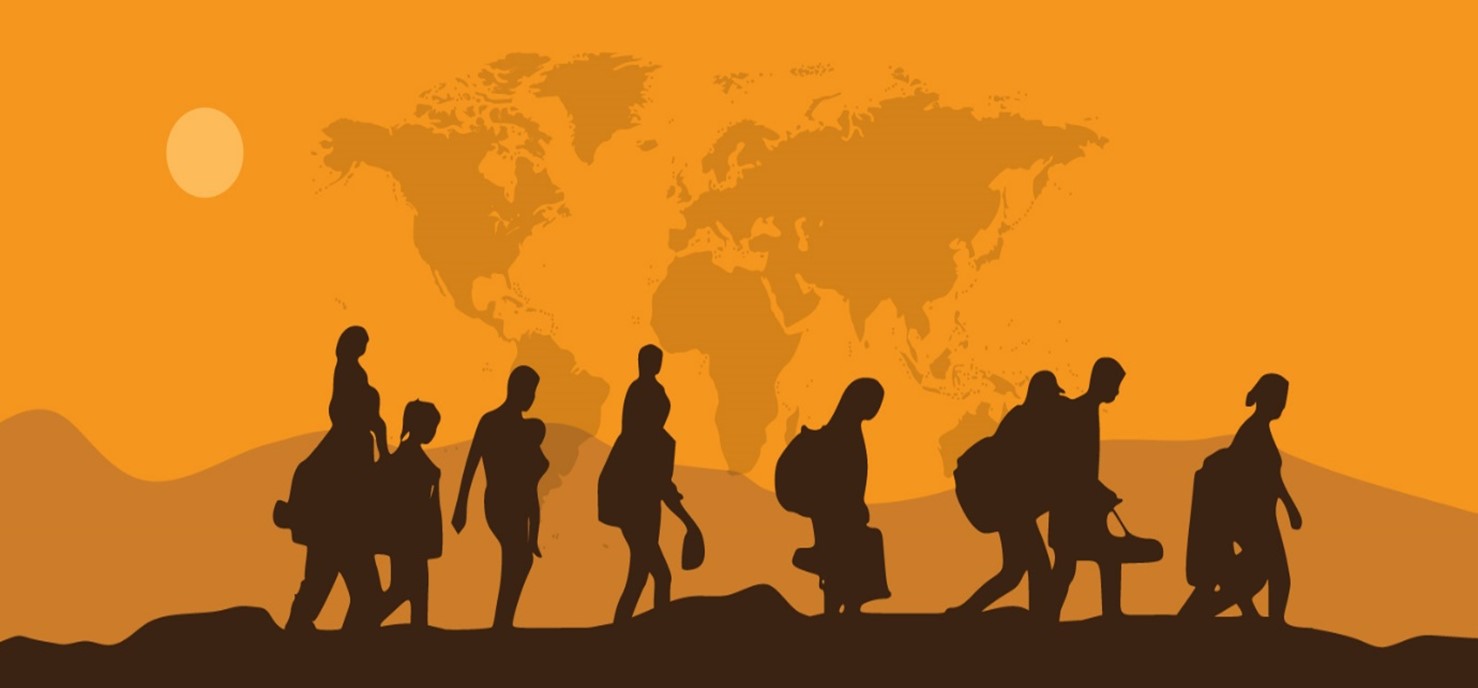- Courses
- GS Full Course 1 Year
- GS Full Course 2 Year
- GS Full Course 3 Year
- GS Full Course Till Selection
- Essay Target – 150+ Marks
- Online Program
- GS Recorded Course
- NCERT (Recorded 500+ Hours)
- Polity Recorded Course
- Geography Recorded Course
- Economy Recorded Course
- AMAC Recorded Course
- Modern India, Post Independence & World History
- Environment Recoded Course
- Governance Recoded Course
- Science & Tech. Recoded Course
- International Relations and Internal Security Recorded Course
- Disaster Management Module Course
- Ethics Recoded Course
- Current Affairs Recoded Course
- CSAT
- 5 LAYERED ARJUNA Mentorship
- Public Administration Optional
- ABOUT US
- OUR TOPPERS
- TEST SERIES
- FREE STUDY MATERIAL
- VIDEOS
- CONTACT US
Global Trends: Forced Displacement in 2022
Global Trends: Forced Displacement in 2022


Latest Context:
Recently, a report was released by the United Nations High Commissioner for Refugees (UNHCR) which revealed that the year 2022 witnessed a high increase in the number of people displaced from their homes due to social and climate crisis.
Highlights of the Report are:
- As per the report, the number of people who were forced to leave their homes due to reasons like persecution, conflict, violence, human rights violations and events seriously disturbing public order reached a record high of 108 million by the end of the year 2022.
- Report also mentioned that almost 30% of them were children.
- The data of 2022 showd an increase of almost 19 million people compared to the year 2021.
- Out of the global total of 108 million forcibly displaced people, almost 35.3 million were refugees (people who crossed an international border to find safety). Basically, the forced displacement can be internal as well as external, depending on whether the displaced people remain within their country of origin or cross an international border.
- The biggest reason for displacement in 2022 was the war in Ukraine, which started in February 2022 and created one of the largest displacement crisis since World War II.
- Other conflicts also added to the forced displacement across the world, such as the crisis in the Democratic Republic of the Congo (DRC), Ethiopia and Myanmar, where almost 1 million people were displaced within each country.
- Presently, the situation has even worsened as the number of people displaced across the world increased to 110 million in May 2023, due to fresh conflict in Sudan.
- Other than the conflict and violence, the climate change and natural disasters has also given a push to displacement.
- Almost 90% of the displaced population originated from Low- and middle-income countries.
- Statelessness further increased the challenges faced by these refugees as they are not able to get even the basic necessities like healthcare, education, and employment.
- Almost 4.4 million people in the world were stateless or of undetermined nationality in 2022 and is a 2% increase from the year 2021.
So, What are the Impacts of Forced Displacement?
- Lead to Humanitarian Crisis: Forced displacement often leads to a humanitarian crisis, with people being uprooted from their homes due to conflicts, persecution, natural disasters, or other factors. This results in a sudden surge in the number of people needing shelter, food, water, healthcare, and other basic necessities, placing a significant burden on humanitarian organizations and host countries
- Loss of Lives and Livelihoods: Forced displacement can result in the loss of lives, as people may face violence, disease outbreaks, or dangerous journeys while fleeing their homes. Displaced individuals also experience the loss of their livelihoods, as they are often forced to leave behind their jobs, land, and assets, which can have long-term economic consequences.
- Strain on Host Communities: When displaced individuals seek refuge in neighbouring communities or countries, it can strain the resources and infrastructure of the host communities. This includes increased demand for housing, education, healthcare, and other public services, which may already be limited. The sudden influx of displaced populations can lead to competition over scarce resources and potential social tensions.
- Socio-economic Challenges: Forced displacement can disrupt the socioeconomic fabric of both the displaced population and the host communities. Displaced individuals often face limited access to education and employment opportunities, leading to poverty and dependency on aid. Host communities may experience economic strains, including job market pressures and increased demand for social services.
- Health Risks: Displaced populations are often exposed to health risks due to overcrowded living conditions, inadequate sanitation facilities, limited access to clean water, and limited healthcare services. This makes them vulnerable to infectious diseases, malnutrition, mental health issues, and other health challenges. Women, children, and the elderly are particularly susceptible to these risks.
- Disruption of Education: Forced displacement disrupts the education of displaced children and youth. Displacement often leads to the closure of schools, lack of access to educational facilities, language barriers, and limited resources for learning. This can have long-term consequences, hindering their personal development and future opportunities.
- Psychological and Emotional Impact: Forced displacement can have severe psychological and emotional effects on individuals. The trauma of leaving behind their homes, witnessing violence, or experiencing loss can result in post-traumatic stress disorder, anxiety, depression, and other mental health conditions. Displaced individuals may also face social isolation, discrimination, and stigmatization in host communities.
- Challenges of Return and Reintegration: When displaced individuals eventually return to their homes or seek to reintegrate into society, they often face numerous challenges. These include rebuilding infrastructure, addressing property disputes, restoring social networks, and overcoming the psychological and emotional scars of displacement.
Ways to address forced displacement are:
- Conflict Prevention and Resolution: Addressing the root causes of conflicts and promoting peaceful resolutions can help prevent forced displacement in the first place. This includes diplomatic efforts, mediation, and promoting dialogue among conflicting parties to reduce tensions and find peaceful solutions.
- Protection of Human Rights: Upholding and protecting human rights, including the rights of displaced individuals, is crucial. Governments should ensure the implementation of laws and policies that safeguard the rights of all individuals, irrespective of their displacement status. This includes access to legal aid, protection against discrimination, and measures to prevent violence and exploitation.
- Humanitarian Assistance and Support: Providing adequate humanitarian assistance is essential to meet the immediate needs of displaced populations. This includes shelter, food, water, healthcare, and sanitation facilities. International organizations and governments should work together to ensure timely and effective delivery of humanitarian aid to those affected by forced displacement.
- Long-term Development and Integration: To address the long-term impacts of forced displacement, efforts should be focused on sustainable development and integration. This includes providing access to education, vocational training, and employment opportunities for displaced individuals. Supporting local economies in host communities can help create jobs and mitigate tensions between the displaced population and host communities.
- Regional Cooperation and Burden-Sharing: Encouraging regional cooperation and burden-sharing among countries facing similar displacement challenges can help distribute the responsibility more equitably. This involves sharing resources, expertise, and best practices to address the needs of displaced populations and reduce the strain on individual host countries.
- Durable Solutions: Promoting durable solutions for forced displacement involves addressing the different needs of displaced individuals. This can include voluntary and safe return to their places of origin when conditions allow, local integration in host communities with access to basic rights and services, or resettlement in a third country for those who cannot return or integrate locally.
- Education and Skill Building: Ensuring access to quality education for displaced children and youth is crucial. Education can provide a sense of normalcy, restore hope, and build the skills necessary for future opportunities. Efforts should be made to provide education in emergency situations and promote inclusive and safe learning environments for displaced populations.
- Mental Health and Psychosocial Support: Recognizing the psychological and emotional impact of forced displacement, there should be a focus on providing mental health and psychosocial support services. This includes counselling, trauma healing programs, and community-based interventions to address the psychological well-being of displaced individuals.
- Empowering Local Communities: Engaging and empowering local communities in the response to forced displacement can lead to more effective and sustainable solutions. This involves including host communities in decision-making processes, promoting social cohesion, and fostering dialogue to address tensions and misconceptions.
- International Cooperation and Funding: Increased international cooperation and financial support are crucial to effectively address forced displacement. Donor countries, international organizations, and development banks should provide adequate funding and support to governments and organizations working on displacement issues.
Conclusion
It is important to understand that the impacts of forced displacement are complex and varied, and they can differ depending on factors such as the cause of displacement, the duration of displacement, the support provided to the affected populations, and the resilience of the individuals and communities involved. By implementing a comprehensive approach, involving various stakeholders and tailored to specific contexts, we can work towards mitigating the impacts of forced displacement and supporting those affected by it.
Mains:
Q. “Refugees should not be turned back to the country where they would face persecution or human right violation”. Examine the statement with reference to ethical dimension being violated by the nation claiming to be democratic with open society. (2021)
Q. Rehabilitation of human settlements is one of the important environmental impacts which always attracts controversy while planning major projects. Discuss the measures suggested for mitigation of this impact while proposing major developmental projects. (2016)




